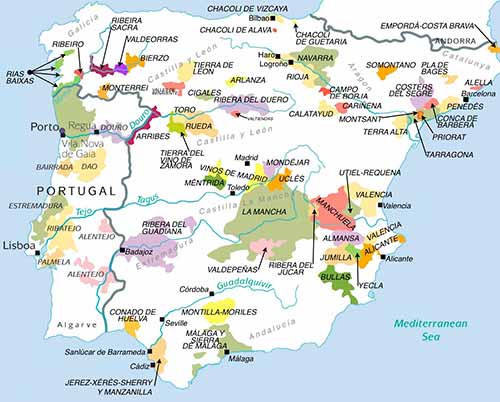
Spain's Wine History
Viticulture has likely been a part of Spain and its culture as far back as 65 million to 2.5 million years ago! Spain’s prominent wine culture and history in the world accelerated greatly when the Romans defeated the Carthaginians and what was to become Spain became a part of the Roman Empire.
The Romans named the Peninsula “Hispania”, and kicked off a golden age for Spanish wines. Afterwards, the Middle Ages brought monks from different orders to Spain, and these monks played a vital role in establishing better production techniques – along with creating what would evolve into Spain’s current DO wine classification system. Most of the wines sold at this time went to English markets, and competed actively with French wines.

Christopher Columbus’ discovery of the New World brought an expansion of Spanish wines exports, as the Spanish conquistadors took Spanish vines on their adventures as they established new Spanish colonies. This was the beginning of wine history in the New World.
Today, Spain remains one of the main wine producing regions in the world, with wines that are highly revered by wine lovers globally. With such an old wine tradition, who can resist a glass of Spanish wine?
Spain’s Wine Regions and Types:
Spain has one of the most varied wine cultures in the world, mainly because of the high number of Spanish grape varieties. Spain encompasses fourteen major regions, from Andalusia to Castile y Leon to Madrid to Valencia. Although the best known type of Spanish wine is red wine, Spain also produces very high quality white wines. There are more than 100 Spanish grape varieties.
There are over 70 designations of origin to classify all Spanish wines in Spain’s different wine regions. This “Denominaciones de Origen” – Designation of Origin, or DO— is used to categorize wines from a given area that usually have common characteristics due to similar terriors – weather, soil, water, and so forth. This system, created in 1932 by Spanish law, is quite similar to France’s Appellation d’Origine Contrôlée (AOC) system. It enables wine customers to know in advance what they’re buying, and to be able to differentiate between all the different Spanish wines. Wines designated Vinos con Denominación de Origen (DO) are prestigious wines that come from a defined production area and with a studies and regulated production, governed by a Regulatory council.

Castile y León (Castile and León) is located in the middle/northwest area of Spain, where its terrior is composed mainly of dry expanses of land, much of which is devoted exclusively to wine production. Castile and Leon produces some of Spain’s best wines, with designations of origin like DO Toro and DO Rueda.
The DO Rueda Wine Region and the Verdejo Grape:
Rueda is a wine region in the heart of the Iberian Peninsula, located just northwest of Madrid, Spain’s capital city. The region is known for its fresh, dry, aromatic white wines made predominately from the Verdejo grape. Rueda officially became a Denominación de Origen (DO) in 1980. Under these guidelines, wines labeled “Rueda Verdejo” must contain a minimum of 85% Verdejo, and generally are made entirely with Verdejo grapes. Interestingly, Verdejo grapes are usually harvested at night.
Verdejo, the base of most Rueda wines, is one of the best white grapes of Spain. The grape originated in North Africa, and was spread to Rueda in about the 11th Century, and has been grown in the region for more than 1000 years. The Verdejo grapes produce soft, fruit-forward white wines with intense aromas. They have bright citrus and melon characteristics, with tons of freshness. Verdejo wines are a wonderful alternative and “change of pace” to wines like Sauvignon Blanc and Pinot Grigio.

One of the best ways to drink Verdejo is alongside food, where the wine’s higher acidity and subtle bitterness allow it to work well as a palate cleanser. As a general rule, if your meal would work well with lime, then it will pair well with Verdejo. Also, Verdejo wines will work well with dishes with cream or coconut-based sauces. Enjoy!
